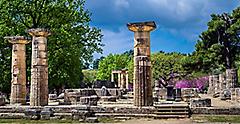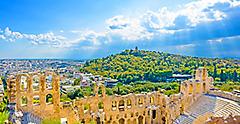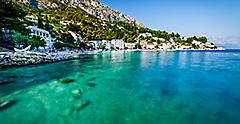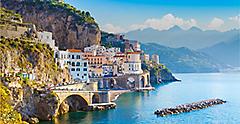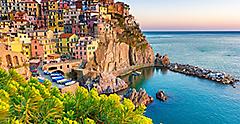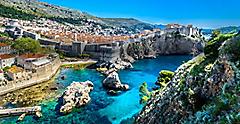There is so much history waiting to be discovered when you explore ancient Greek architecture. Whether you're visiting Athens, walking the streets of Santorini or visiting the old city of Delphi, you're sure to discover hidden gems of ancient ruins that still stand alongside modern buildings.
Grecian architecture has withstood the test of time, and its style is still echoed in major structures today. From the shores of Mykonos to the Classical Age architectural masterpiece that is the Parthenon, the splendor of ancient Greece is waiting for you.
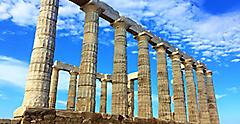
Greek architecture reached its zenith between 900 B.C. and the first century A.D., and much of what's still standing today are buildings from this time. Many of the most famous structures belong to the Mycenean Age (1600 – 1100 B.C.) and the Classical Age (500 – 336 B.C.)..
The stunning architecture of Ancient Greece influenced many civilizations, particularly the Roman Empire and modern civilizations of the West. You can see Greek-inspired architecture all over the world today, from government buildings to grand palaces.
Greek Temples
Some of the most recognizable ancient Greek structures are the Greek temples with their iconic columns. There are three types of columns that can still be widely seen in ancient Greek architecture: Doric, Ionic and Corinthian. Doric architecture emerged on the Greek mainland during the late 7th century B.C., and these are the simplest and thickest of the column types. They are thick at the bottom and thin at the top without any extra engraving. Despite their simplicity, they are featured on the most iconic building in Greece, the Parthenon, as well as the Temple of Apollo at Thermon.
The Ionic column style originated in the coastal region of Ionia, which is now Turkey. This style is more ornate in design — the column is thinner and the top is decorated with scrolls on each side. One of the first great Ionic buildings is the temple dedicated to Hera on the island of Samos. You can also see Ionic architecture in the interior of the monumental gateway to the Acropolis, which is known as the Propylaia.
Corinthian-style columns originated in the Greek city-state of Corinth. This style is the most ornate of the three. The top is decorated with scrolls and acanthus plant leaves, which symbolize immortality. This style is so beautiful that the Romans frequently copied this design when constructing their buildings. The Temple of Apollo Epicurius at Bassae is the earliest known Corinthian architecture.
While they had a fairly simple design, Greek temples were, and still are, grand. Above the columns, you will see the frieze, a decorative panel of sculptures. The pediment is a triangular panel above the frieze featuring yet more sculptures. Inside the temple, the chamber housed the statue of the god or goddess that the temple was built for.
It goes without saying that the most famous temple of ancient Greek architecture is the Parthenon, built for Athena and completed in 432 B.C. Its Doric style may have been a simpler design, but with 46 columns that are six feet in diameter, its grandeur is undeniable. The statue of Athena inside was constructed from gold and ivory.
Other famous temples across Greece are the Doric-style Temple of Olympia Zeus in Olympia, the Ionic architecture of the Erechtheum on the north side of the Acropolis in Athens and the Temple of Aphrodite Uraniam, also located in Athens.
The Architecture Of Theaters And Stadiums
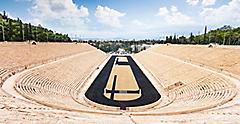
Some of the largest theaters of ancient Greece could hold up to 10,000 people, and the bigger stadiums could seat 30,000-45,000 people. Often, these were built into hillsides, which helped amplify sound so even the people in the back row could hear the actor on stage.
Stadiums: Known to onlookers as the stadion, ancient Greek stadiums were important cultural centers for this sports-loving society. These stadiums even had VIP sections for some guests. The stadiums were frequently used for foot races and famously used for what we know as the Great Games, which were the ancient version of the Olympics. The major competitions in these stadiums were held every two to four years and honored a deity or god. Because ancient sporting events were closely connected to religion, you can imagine the pageantry of the games along with the grandeur of the stadiums themselves. When you're in Athens, take a stop at the Panathenaic Stadium, the host of the first modern Olympics in 1896 and the only stadium in the world made entirely of marble.
Theaters: The buildings that housed dramatic productions were called theatron. Usually quite large, open-air and also constructed on hillsides, theatron were made up of three main components: the orchestra, the skene and the audience.
The orchestra is at the center of the theater in a rectangular or circular shape. This is where the play, dance, religious rites and acting took place. The skene is a large rectangular building behind the orchestra and would be known today as the backstage area. Here, actors could change costumes, masks and makeup. Sometimes the skene was painted with a backdrop that suited the play. The audience, of course, surrounded the stage area in a semi-circle, but the actors had to make grand gestures so the audience could see, hear and understand the story. Even as time progressed, these three main components continued to make up the design of Greek theaters.
The ancient Greek theatrical culture is one that has echoed through history. Flourishing by 700 B.C., Athens was the epicenter for political and military power, and dramatic theater made up a large part of Athens' cultural growth during this time. But theatrical traditions weren't just centered in Athens — they spread rapidly across the country, too.
During the earlier stages of theater, the actors, directors and dramatists were all the same person. It was essentially a one-man show. Eventually, three actors performed at the same time and a few non-speaking roles were added. Because of the limited roles, music became an integral piece of ancient Greek theater. Satyr (a form of tragicomedy featuring male nature, usually full of comedic tropes like drunkenness, pranks and sexual innuendos), tragedy and comedy were the most common genres of ancient Greek plays.
The Theatre of Dionysus (built in the 6th century B.C.E) and the Odeon of Herodes Atticus (161 A.D.) are two theaters you shouldn't miss in Athens!
Grecian Home Architecture

It goes without saying that the Greeks loved marble, as a lot of ancient structures uncovered today were constructed from it. But marble was expensive and used mainly in grand structures — think the Parthenon, the Acropolis, the Theseum or the temple of Olympus Zeus. In contrast, everyday homes were typically made of limestone or walls of mud-brick that rested on stone support columns with floors made of beaten clay and tiled roofs.
Typically, homes were centered around a courtyard at the innermost part of the house. It provided a lot of natural light for the relatively small homes. The ground floor rooms were the kitchen, storage rooms and sometimes the animal pens and a bathroom. Also on the first floor was the chief room, which was known as the andron and used only by men. The women's and children's quarters were housed on the second floor, separate from the men's quarters. If you find yourself touring ancient homes, be on the lookout for these key features.
While the average ancient Greek person's home was unlikely to have running water, the Palace at Knossos, located on modern-day Crete, is where the first flushing toilet was created. In fact, Crete was the first city in Greece to implement plumbing. They took advantage of their steep lands and created underground pipes using clay to send the waste to sewage canals they built. In fact, many of the ancient sewage systems are still in use today, updated in some spots.
Examples Of Ancient Architecture

Here are some of the best places to find unique ancient Greek architectural examples.
The Grecian Islands
From idyllic beaches to ancient ruins, you are spoiled for choice when looking for ancient wonders on the Greek Isles. The Temple of Aphaia looms over Aegina, while Delos Island hosts the incredible Terrace of the Lions and the island of Corfu is home to the Doric Temple of Artemis, which dates back to 580 B.C. On Rhodes, you'll find the world-famous Acropolis. Cephalonia's capital city of Argostoli is home to one of the most important archeological museums in the country. It specializes in the Mycenaean era and is a must-see when visiting.
Many of the Cycladic Islands like Mykonos and Santorini are famous for their distinct Cycladic architecture with its white, angular buildings. The famous structures were built close together on narrow streets during the medieval era, but the islands' architectural history stretches back much farther than their iconic white buildings. On Santorini, you can visit the village of Akrotiri for a glimpse at the partially excavated Minoan village, which is believed to date back to 4,500 B.C. The Ancient Theater in Milos and the Temple of Demeter on Naxos also harken back to Greece's Classical period of architecture.
From the in-progress archaeological digs at Delos to the Old Towns of Crete and Rhodes, the Greek Islands are brimming with history, artifacts and antiquity. Worlds of architectural discoveries await you at each stop.
Athens
In Athens, art lovers, epicureans and history buffs will all be enthralled. You'll find ancient ruins and museums conveniently located close to port, including the Archaeological Museum of Piraeus, which is located just 10 minutes from port and is filled with sculptures dating from the Bronze Age to the Romans. You can walk the Zea Harbour to get to the Hellenic Maritime Museum, which brings to life the grandeur of ancient Greece's naval capacities.
Other Athens highlights include the Academy where Aristotle studied for 20 years beginning in 367 B.C., Hadrian's Arch from 131 B.C., the Doric Temple of Olympian Zeus and, of course, the majestic Acropolis. See if you can spot the Corinthian columns within the National Gardens' 160,000 square meters, where you'll also find mosaics, ruins, wildlife and historic artifacts. Conclude your day with a walk through the picturesque Plaka, the city's most ancient neighborhood.
A visit to Athens wouldn't be complete without visiting The Agia Triada. It's one of the finest examples of Byzantine-style architecture in Greece along with the Church of St. Nicholas, which overlooks the port and has a magnificent interior filled with Orthodox icons, frescoes and sculptures. If you're looking for some time in nature, head to Mikrolimano. It's the smallest and most picturesque port of Athens, making it perfect for a romantic afternoon.
Legacy Of Grecian Architecture
As you're walking through the streets of Athens or exploring the islands, it's rewarding to recall just how far this architecture spread. The Grecian style of architecture has been continuously popular, enjoying sporadic "rediscoveries" during the Renaissance, the mid-18th century and further into the Neo-Classical movement (late-18th to early-19th century). Greece always has new surprises, too. In 2018, new discoveries were made, including the oldest known written excerpt of Homer's "Odyssey" and ancient homes on the deserted island of Despotiko. Cruising to Greece offers so many adventures, and ancient Greek architecture is one of the best reasons to keep coming back.
Get Royal Deals, Sign Up Today

Getting There
Explore Our Most Affordable Itineraries
Learn about the types of Greek architecture you can explore during your Mediterranean cruise

